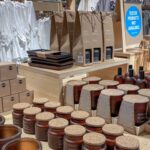Starting a home garden or taking up gardening brings nature closer to your daily life. Growing your own vegetables at home through container gardening can also help you save money.
If you’re cultivating plants at home, you might be thinking about reducing your environmental impact. Naturally, you’d want to choose planters that are kind to the environment as well.
This article introduces how to choose sustainable planters and recommends some excellent products.
What Are Sustainable Planters?
What Makes Materials Environmentally Friendly?
Choosing the right materials for your planters is crucial for achieving sustainable gardening. Let’s explore materials that reduce environmental impact while supporting healthy plant growth.
Recycled Materials
Planters made from recycled materials and recycled plastics are gaining attention. By reusing resources that would otherwise become waste, these planters minimize environmental burden while providing all the necessary functions for plant cultivation—perfect for those wanting to start eco-conscious growing.
Natural Materials
Wooden planters offer natural charm and excellent breathability, making them ideal for growing leafy vegetables and herbs. Choosing products with anti-rot treatment extends their lifespan significantly.
Fabric and non-woven planters are lightweight and easy to handle, with the flexibility to adjust size as plant roots grow. They’re particularly valuable when frequent moving or repositioning is needed.
Durable Long-Lasting Materials
Terracotta (unglazed clay) excels in breathability and drainage, reducing root rot risks and performing exceptionally well for vegetable cultivation. However, they’re fragile to impact and heavy, requiring careful consideration of placement.
Ceramic planters are unmatched in visual appeal but can be heavy with potentially poor drainage. They work well for a wide range of plants, from root vegetables to fruiting crops.
Why Choose Sustainable Planters?
Reducing Plastic Waste Sustainable material planters serve as excellent alternatives to traditional plastic containers, significantly contributing to waste reduction.
When these planters deteriorate and need disposal, choosing materials that naturally decompose reduces environmental burden.
Cost Savings Through Long-Term Use
While initial investment may be higher, selecting durable materials provides long-term economic benefits. Choosing timeless designs you won’t tire of ensures years of cherished use.
Combining Aesthetics with Environmental Responsibility
This creates an ideal solution for building beautiful garden spaces while caring for our planet. Rather than following trends, focus on creating spaces you genuinely love.
Key Points for Selecting Planters
How to Choose the Right Size
Matching Container Volume to Your Plants
Different plants require vastly different amounts of soil and root space. Large vegetables like tomatoes and eggplants need depths of 30cm or more with 10-20L capacity, while herbs and leafy greens do well in shallow containers of 3-8L.
Recommended Planter Sizes by Vegetable
| Vegetable | Recommended Size (Depth × Width/Diameter) | Soil Volume | Recommended Materials | Key Points |
|---|---|---|---|---|
| Tomatoes, Eggplant | 30cm+ deep × 30cm+ diameter / 60-80cm wide (2 plants) | 10L-20L | Terracotta, wood, unglazed clay, fabric | Deep containers for stakes, prioritize drainage |
| Cherry Tomatoes | 35cm+ deep × 30cm diameter | 10L | Terracotta, wood, fabric | Depth important for stake installation |
| Peppers | 30cm+ deep × 30cm+ diameter | 10L | Terracotta, wood, ceramic | Choose width and depth for proper plant spacing |
| Cucumbers | 35cm+ deep × 30cm+ diameter | 10L-20L | Wood, fabric, terracotta | Stable containers for vine training |
| Daikon, Carrots | 30cm+ deep × 30cm+ diameter | 10L-15L | Unglazed clay, paper, fabric, wood | Deep containers essential for root development |
| Turnips, Radishes | 20-30cm deep × 20-30cm diameter | 5L-10L | Unglazed clay, paper, fabric | Breathable, well-draining shallow containers |
| Leafy Greens (lettuce, spinach, komatsuna) | 10-25cm deep × 40-65cm wide | 5L-15L | Wood, fabric, paper, rice hull materials | Breathable, well-draining shallow containers |
| Herbs (basil, etc.) | 10-15cm deep × 20-40cm wide | 3L-8L | Unglazed clay, fabric, wood, eco materials | Well-draining containers best for moisture-sensitive plants |
Balcony and Indoor Space Considerations
To maximize limited space effectively, measure your intended placement area beforehand and select appropriate sizes.
Material Characteristics: Pros and Cons
Each material has unique properties. Ceramic is beautiful but heavy, wood offers good breathability but may be water-sensitive, and recycled plastic is lightweight but may lack visual appeal. Choose based on your specific needs.
Balancing Style and Functionality
Check Drainage and Weight, Not Just Appearance Consider not only visual appeal but also practical aspects like drainage efficiency and portability that matter in actual use.
Stylish & Practical: 12 Sustainable Planters
Recycled Materials
SGI Recycled Planter Pot
Key Features:
- Recycled plastic material
- Self-watering system
This innovative planter uses completely recycled plastic and features a self-watering system that automatically supplies water as plants need it. The reservoir at the bottom gradually releases moisture into the soil through capillary action. Its smooth texture and calm two-tone coloring harmonize beautifully with interior decor.
Recycled Paper Pot PAPER POT Planter
Key Features:
- Recycled paper material
- Perfect for herbs and leafy vegetables
Made from recycled waste paper, this environmentally considerate planter has minimal environmental impact even during disposal, being made from naturally decomposing materials. Its compact design makes it ideal for growing herbs and leafy greens.
shesay Eco-Material Flower Pot with Saucer
Key Features:
- Uses recycled plastic
- Available in multiple sizes
This planter uses a unique eco-material combining stone powder, recycled plastic, and wood powder. While lightweight, it offers high durability and comes in height variations from 10.5cm to 20cm. The subdued coloring blends well with any interior.
eco&eco Win Planter Deep 45 Type 3-Piece Set
Key Features:
- 100% recycled materials
- Large capacity design
Made entirely from recycled materials, this planter features legs that elevate it from the ground, improving air circulation. Its large capacity accommodates various vegetable cultivation needs.
Natural Materials
Square Planter Rectangular (1-Tier) Wooden Planter
Key Features:
- Made in Japan
- Wide size selection
- Customizable
Using domestic cedar from Miyazaki Prefecture, this high-quality Japanese-made product is handcrafted by artisans in a dedicated factory in Hatsukaichi, Hiroshima. With 28 size options available, you can combine them to create your original gardening space. Can also serve as planter covers.
Dux Planter 140 Type Wooden
Key Features:
- Made in Japan
- Slim design
This elongated planter uses domestic cedar and is carefully handmade one by one in a Hatsukaichi, Hiroshima factory. Its slim design works well in narrow spaces, and the 16cm height is perfect for leafy greens and herb cultivation.
Root Pouch S Size Non-Woven Fabric Pot
Key Features:
- Mixed material of recycled plastic and cotton
- Optimal for herbs and leafy vegetables
Made from a blend of recycled plastic bottles and cotton, this non-woven fabric planter has no drainage holes but achieves excellent drainage through material properties. Perfect for herb and leafy green cultivation, it includes handles for easy mobility.
Ceramic & Terracotta
Decorative Ceramic Pot Isle Egg (3 Colors)
Key Features:
- Ceramic construction
This ceramic planter includes drainage holes and a matching saucer. Its rounded form creates a gentle impression, while the antique-style finish adds elegance to any space.
Ceramic Planter S Size with Saucer – Japanese Made Mino Ware
Key Features:
- Made in Japan
- Uses recycled materials
Manufactured by Shinzan Kiln Yamatsu in the Mino region, Japan’s largest ceramic production area, this domestic product uses recycled clay called “ground,” which incorporates finely crushed broken ceramics. It comes with a matching saucer, and changing saucers can alter the overall atmosphere. The low height makes it suitable for herbs and leafy greens.
Terracotta Plant Pot 11-Inch DEROMA Vasocono
Key Features:
- High-quality terracotta
- Simple, refined design
This high-quality Italian terracotta planter incorporates silicone in the clay to reduce water seepage, making it suitable for indoor use. Its simple, sophisticated shape is particularly attractive.
Decorative Terracotta Fritt Egg (2 Colors)
Key Features:
- Terracotta ceramic
- Antique treatment
Made from terracotta ceramic with drainage holes (saucer sold separately), this planter features antique treatment for a natural, richly textured appearance.
Large Terracotta Plant Pot Antique-Style Paint Planter 10-Inch
Key Features:
- Terracotta ceramic
- Large capacity
This large terracotta ceramic planter features antique-style painting that creates stylish garden and terrace spaces.
Maintenance Tips for Long-Term Use
Care Methods by Material
Ceramic requires protection from freeze damage, metal needs proper water drainage to prevent rust, wood needs regular anti-rot treatment to prevent decay, and recycled materials should avoid excessive direct sunlight to prevent UV degradation. Each material requires specific care approaches.
Preventing Mold and Deterioration
Ensuring Proper Drainage Regularly check that drainage holes aren’t clogged to maintain proper drainage, and clean them as needed.
Regular Cleaning Prevent dirt and algae buildup by cleaning with neutral detergent each season.
Conclusion
Choosing planters that simultaneously achieve beauty, functionality, and environmental responsibility is the first step toward sustainable gardening. For beginners, we recommend starting with medium-sized terracotta or wooden planters that offer excellent drainage and easy handling. The right combination of materials and sizes will help you begin a gardening life you’ll cherish for years to come.



















